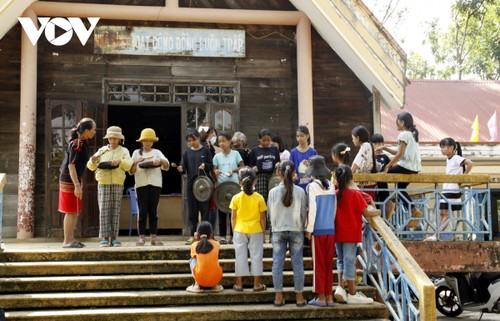 The girls gather at Buon Trap communal house to learn gong. (photo: VOV) The girls gather at Buon Trap communal house to learn gong. (photo: VOV) |
On weekends 20 girls gather in the front yard of the communal house in Buon Trap town, Krông Ana district, to learn gong from their instructors.
12-year-old H Doanh Eban said: “My grandmother introduced me to the class. I love playing gongs and dancing, so I was eager to join. I’m very excited about learning and preserving our traditional culture.”
For two months they have been learning the three basic gong performances – welcoming guests, celebrating the new rice crop, and praying for good health – and dancing to celebrate the new crop. These are traditional gong melodies and dances of the Eđê Bih in Krông Ana district, which are only taught to women and girls.
H Lam Hmok, who is in charge of the gong class, said: “At the beginning of the summer, we opened the gong and dancing classes for the children. It takes a lot of time to make the studentsunderstand the meaning of the performances and remember them. I hope all the children will be able to play the gong after this class.”
 Traditional gong melodies and dances of the Êđê Bih in Krông Ana district are only taught to women and girls. (photo: VOV) Traditional gong melodies and dances of the Êđê Bih in Krông Ana district are only taught to women and girls. (photo: VOV) |
Since 2005 when UNESCO recognized “The cultural space of the gong in the Central Highlands” as a Masterpiece of the Intangible Heritage of Humanity, Dak Lak province has worked hard to restore and promote gong culture.
Festivals that feature the gong have been revitalized, gongs and gong melodies have been researched and collected, gongs have been given to hamlets, and gong classes have been organized.
Only Krông Ana district has a female gong team of the Êđê Bih. They play a drum and a set of 6 gongs, called Jho gongs, to produce the soft melodies typical of the Ede who live along the Krong Ana river.
According to Van Duc Tuan, Vice Chairman of the Buon Trap town People’s Committee, the female gong team always has new young players. They have performed at many festivals and cultural exchanges in Dak Lak and other provinces.
“Buon Trap town has two generations of gong players – the artisans, who are around 60 or 70 years old, and players who are under 30. They are teaching the children of Buon Trap to play gongs and restore gong culture,” said Tuan.
The Jho gong class in Buon Trap town is one of three gong classes opened this summer by the Dak Lak provincial Department of Culture, Sports, and Tourism. There is also a Ching Knah class taught by the Ede in Drai Sap commune and a Chung Bor class taught by the M’Nong in Lak district.
The classes are part of a project funded by the International Cooperation Center of Jeollabuk province, South Korea, to help Dak Lak province preserve and promote its gong culture.
Dang Gia Duan, Deputy Director of the Dak Lak provincial Department of Culture, Sports, and Tourism, said: “We are ready to help local artisans organize classes and provide costumes and other equipment so they can preserve and promote Vietnam’s gong culture.”